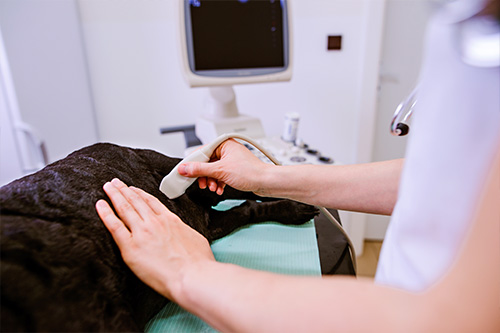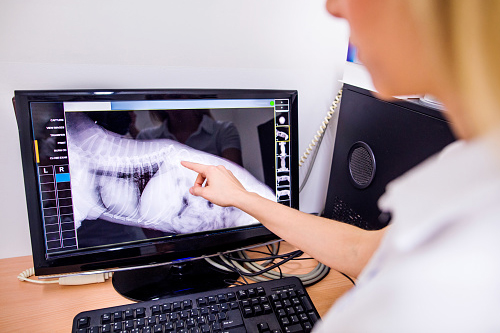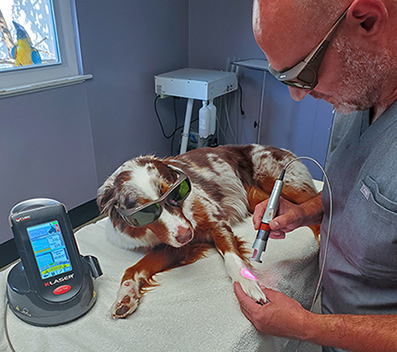
Ultrasonography
Ultrasonography (also called ultrasound or sonography) is a noninvasive, pain-free procedure that uses sound waves to examine a pet’s internal organs and other structures inside the body. It can be used to evaluate the animal’s heart, kidneys, liver, gallbladder, and bladder; to detect fluid, cysts, tumors, or abscesses; and to confirm pregnancy or monitor an ongoing pregnancy.
We may use this imaging technique in conjunction with radiography (x-rays) and other diagnostic methods to ensure a proper diagnosis. Interpretation of ultrasound images requires great skill on the part of the clinician.
The ultrasonographer applies gel to the surface of the body and then methodically moves a transducer (a small handheld tool) across the skin to record images of the area of interest. The gel helps the transducer slide more easily and create a more accurate visual image.
The transducer emits ultrasonic sound waves, which are directed into the body toward the structures to be examined. The waves create echoes of varying degrees depending on the density of the tissue and amount of fluid present. Those waves create detailed images of the structures, which are shown on a monitor and recorded for evaluation.
Ultrasound does not involve radiation, has no known side effects, and doesn’t typically require pets to be sedated or anesthetized. The hair in the area to be examined usually needs to be shaved so the ultrasonographer can obtain a good result.
If you have any questions about our ultrasonography service or what to expect during your pet’s procedure, please don’t hesitate to ask.

Digital Radiology (X-rays)
When we need to figure out what’s wrong with your pet, we routinely use x-rays to help identify the cause of the problem, rule out possible problems, or provide a list of possible causes. We may also use x-rays during a wellness exam to diagnose potential problems before they become serious.
X-rays provide valuable information about a pet’s bones, gastrointestinal tract (stomach, intestines, colon), respiratory tract (lungs), heart, and genitourinary system (bladder, prostate). We use radiology alone or in conjunction with other diagnostic tools. Interpretation of radiographs requires great skill on the part of the veterinarian.
We offer digital radiology (x-rays that are captured digitally rather than on film). This technology allows us to capture extremely clear images, provide you with a quicker diagnosis of your pet, and use less radiation than traditional x-rays.
To provide you with the clearest image(s) possible you pet must remain still and be completely relaxed. Some cases may require your pet to undergo short-acting sedation.
If you have any questions about our radiology service or what to expect during your pet’s procedure, please don’t hesitate to ask.

Cold Laser Therapy
Laser therapy is the use of specific wavelengths of light (red and near-infrared) to stimulate the body’s natural ability to heal. Our specific K-Laser is an FDA cleared therapeutic treatment that manages pain and inflammation while accelerating tissue regeneration. During each painless treatment, infrared laser light interacts with tissues at the cellular level increasing metabolic activity within the cell. The laser energy increases circulation, drawing water, oxygen, and nutrients to the damaged area. By improving the transport of nutrients across the cell membrane, the increased production of cellular energy (ATP) is stimulated. This creates an optimal healing environment that reduces inflammation, swelling, muscle spasms, stiffness, and pain. This enables laser therapy to assist in treating a variety of conditions like skin wounds, tendon and ligament injuries (ACL), trigger points, edema, lick granulomas, muscle injures, osteoarthritis, and post-operative incisions and tissues.
For more information on Cold Laser Therapy please click here.
